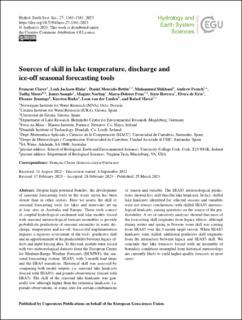| dc.contributor.author | Clayer, Francois | |
| dc.contributor.author | Jackson-Blake, Leah | |
| dc.contributor.author | Mercado-Bettín, Daniel | |
| dc.contributor.author | Shikhani, Muhammed | |
| dc.contributor.author | French, Andrew | |
| dc.contributor.author | Moore, Tadhg | |
| dc.contributor.author | Sample, James | |
| dc.contributor.author | Norling, Magnus | |
| dc.contributor.author | Frias, Maria-Dolores | |
| dc.contributor.author | Herrera, Sixto | |
| dc.contributor.author | de Eyto, Elvira | |
| dc.contributor.author | Jennings, Eleanor | |
| dc.contributor.author | Rinke, Karsten | |
| dc.contributor.author | van der Linden, Leon | |
| dc.contributor.author | Marcé, Rafael | |
| dc.date.accessioned | 2023-04-19T08:35:47Z | |
| dc.date.available | 2023-04-19T08:35:47Z | |
| dc.date.created | 2023-04-11T14:35:26Z | |
| dc.date.issued | 2023 | |
| dc.identifier.citation | Hydrology and Earth System Sciences (HESS). 2023, 27 (6), 1361-1381. | en_US |
| dc.identifier.issn | 1027-5606 | |
| dc.identifier.uri | https://hdl.handle.net/11250/3063732 | |
| dc.description.abstract | Despite high potential benefits, the development of seasonal forecasting tools in the water sector has been slower than in other sectors. Here we assess the skill of seasonal forecasting tools for lakes and reservoirs set up at four sites in Australia and Europe. These tools consist of coupled hydrological catchment and lake models forced with seasonal meteorological forecast ensembles to provide probabilistic predictions of seasonal anomalies in water discharge, temperature and ice-off. Successful implementation requires a rigorous assessment of the tools' predictive skill and an apportionment of the predictability between legacy effects and input forcing data. To this end, models were forced with two meteorological datasets from the European Centre for Medium-Range Weather Forecasts (ECMWF), the seasonal forecasting system, SEAS5, with 3-month lead times and the ERA5 reanalysis. Historical skill was assessed by comparing both model outputs, i.e. seasonal lake hindcasts (forced with SEAS5), and pseudo-observations (forced with ERA5). The skill of the seasonal lake hindcasts was generally low although higher than the reference hindcasts, i.e. pseudo-observations, at some sites for certain combinations of season and variable. The SEAS5 meteorological predictions showed less skill than the lake hindcasts. In fact, skilful lake hindcasts identified for selected seasons and variables were not always synchronous with skilful SEAS5 meteorological hindcasts, raising questions on the source of the predictability. A set of sensitivity analyses showed that most of the forecasting skill originates from legacy effects, although during winter and spring in Norway some skill was coming from SEAS5 over the 3-month target season. When SEAS5 hindcasts were skilful, additional predictive skill originates from the interaction between legacy and SEAS5 skill. We conclude that lake forecasts forced with an ensemble of boundary conditions resampled from historical meteorology are currently likely to yield higher-quality forecasts in most cases. | en_US |
| dc.language.iso | eng | en_US |
| dc.publisher | Copernicus Publications | en_US |
| dc.rights | Navngivelse 4.0 Internasjonal | * |
| dc.rights.uri | http://creativecommons.org/licenses/by/4.0/deed.no | * |
| dc.title | Sources of skill in lake temperature, discharge and ice-off seasonal forecasting tools | en_US |
| dc.type | Peer reviewed | en_US |
| dc.type | Journal article | en_US |
| dc.description.version | publishedVersion | en_US |
| dc.rights.holder | © Author(s) 2023 | en_US |
| dc.source.pagenumber | 1361-1381 | en_US |
| dc.source.volume | 27 | en_US |
| dc.source.journal | Hydrology and Earth System Sciences (HESS) | en_US |
| dc.source.issue | 6 | en_US |
| dc.identifier.doi | 10.5194/hess-27-1361-2023 | |
| dc.identifier.cristin | 2140028 | |
| dc.relation.project | Norges forskningsråd: 274208 | en_US |
| dc.relation.project | EU/690462 | en_US |
| cristin.ispublished | true | |
| cristin.fulltext | original | |
| cristin.qualitycode | 2 | |

